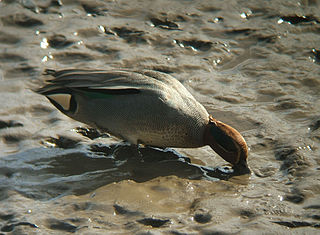 W
WBird ichnology is the study of avian life traces in ornithology and paleontology. Such life traces can include footprints, nests, feces and coproliths. Scientists gain insight about the behavior and diversity of birds by studying such evidence.
 W
WThe scientific question of within which larger group of animals birds evolved has traditionally been called the 'origin of birds'. The present scientific consensus is that birds are a group of maniraptoran theropod dinosaurs that originated during the Mesozoic Era.
 W
WArchaeopterygidae is a group of maniraptoran dinosaurs that lived during the late Jurassic period. In most current classifications, it contains only the genera Archaeopteryx and Wellnhoferia. As its name suggests, Protarchaeopteryx was also once referred to this group, but most paleontologists now consider it an oviraptorosaur. Other referred genera, like Jurapteryx, Wellnhoferia, and "Proornis", are probably synonymous with Archaeopteryx or do not belong into this group. Jinfengopteryx was originally described as an archaeopterygid, though it was later shown to be a troodontid. A few studies have recovered Anchiornis and Xiaotingia to also be members of the Archaeopterygidae, though most subsequent analyses have failed to arrive at the same result. Uncertainties still exist, however, and it may not be possible to confidently state whether archaeopterygids are more closely related to modern birds or to deinonychosaurs barring new and better specimens of relevant species.
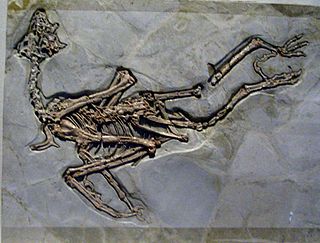 W
WAvebrevicauda is a group which includes all avialan species with ten or fewer free vertebrae in the tail. The group was named in 2002 by Gregory S. Paul to distinguish short-tailed avialans from their ancestors, such as Archaeopteryx, which had long, reptilian tails.
 W
WThe Bahaman caracara, also known as Creighton's caracara, is an extinct bird of prey. It is known only from a few fossils discovered in the Bahamas and Cuba. Caracara creightoni was a scavenger and opportunistic species instead of a predator like its sister extant species. It lived during the late Pleistocene to the beginning of the Holocene era.
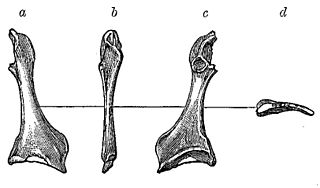 W
WCimolopterygidae is a group of extinct birds known from the late Cretaceous Period. Remains attributed to cimolopterygids have been found in the Frenchman Formation of Saskatchewan, the Lance Formation of Wyoming, the Fox Hills Formation of Colorado, the Hell Creek Formation of Montana, and the Allen Formation of Rio Negro, Argentina. Most date to the end of the Maastrichtian age, about 66 million years ago, though a much earlier species has also been identified from the Campanian-aged Dinosaur Park Formation of Alberta, about 75 million years ago.
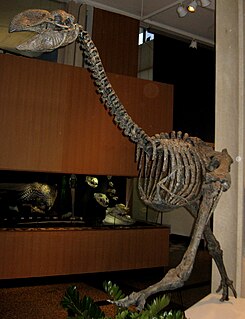 W
WDromornithidae, also commonly referred to as mihirungs, thunder birds or demon ducks, were a clade of large, flightless Australian birds of the Oligocene through Pleistocene Epochs. All are now extinct. They were long classified in Struthioniformes, but are now usually classified as galloanseres.
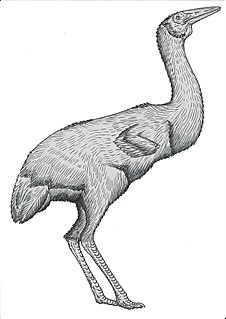 W
WEogruidae is a family of large, flightless birds that occurred across Eurasia from the Eocene to Pliocene epochs. Related to modern cranes, limpkins and trumpeters, these birds converged strongly with ostriches due to similar speciations to cursoriality, even reducing their number of toes to two in some taxa. It has been suggested that competition from true ostriches has caused the extinction of these birds, though this has never been formally tested and several ostrich taxa do occur in the late Cenozoic of Asia and some species do occur in areas where ostrich fossils have also been found.
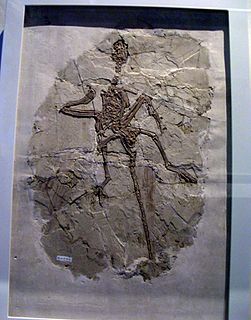 W
WEuavialae is a group of theropods which includes all avialan species more closely related to modern birds than to the basal, long-tailed birds Archaeopteryx and Jeholornis.
 W
WGargantuavis is an extinct genus of large, primitive bird containing the single species Gargantuavis philoinos. It is the only member of the monotypic family Gargantuaviidae. Its fossils were discovered in several formations dating to 73.5 and 71.5 million years ago in what is now northern Spain, southern France, and Romania. Gargantuavis is the largest known bird of the Mesozoic, a size ranging between the cassowary and the ostrich, and a mass of 140 kg (310 lb) like modern ostriches, exemplifying the extinction of non-avian dinosaurs was not a necessary condition for the emergence of giant terrestrial birds. It was once thought to be closely related to modern birds, but the 2019 discovery of a pelvis from what was Hateg Island shows several primitive features.
 W
WGastornithidae is a family of prehistoric birds. The various species in this group lived from the Paleocene to the Eocene epochs and ranged from Asia and Europe to North America. All known species were very large, flightless ground birds, similar to ostriches but more heavily built and with huge beaks. Once thought to be carnivores, they are now considered to have been primarily herbivorous.
 W
WGastornithiformes were an extinct order of giant flightless fowl with fossils found in North America, Eurasia, and possibly Australia. Members of Gastornithidae were long considered to be a part of the order Gruiformes. However, the traditional concept of Gruiformes has since been shown to be an unnatural grouping. Beginning in the late 1980s and the first phylogenetic analysis of gastornithid relationships, consensus began to grow that they were close relatives of the lineage that includes waterfowl and screamers, the Anseriformes. Recognizing the apparent close relationship between gastornis and waterfowl, some researchers even classify them within the anseriform group itself. Others restrict the name Anseriformes only to the crown group formed by all modern species, and label the larger group including extinct relatives of anseriformes in the clade Anserimorphae. While the order is generally considered to be monotypic, a 2017 paper concerning the evolution and phylogeny of giant fowl by Worthy and colleagues have found phylogenetic support in finding the mihirungs (Dromornithidae) to be the sister taxon to the gastornis. The mihirungs are also another family of giant flightless birds that have been classified as anserimorphs either as crown anseriforms closely related to the screamers (Anhimidae) or the sister taxon to Anseriformes. Worthy et al. (2017) incorporated several new taxa and character traits into existing matrices of Galloanserae resulted in several of their phylogenies to support this grouping. The authors did note the bootstrap support is weakly supported and one of their phylogenies even found gastornithiforms to be stem galliforms instead. These were also weakly supported. Below is a simplified phylogeny showing their one phylogeny supporting gastornithiforms as anserimorphs.
 W
WHesperornithes is an extinct and highly specialized group of aquatic avialans closely related to the ancestors of modern birds. They inhabited both marine and freshwater habitats in the Northern Hemisphere, and include genera such as Hesperornis, Parahesperornis, Baptornis, Enaliornis, and Potamornis, all strong-swimming, predatory divers. Many of the species most specialized for swimming were completely flightless. The largest known hesperornithean, Canadaga arctica, may have reached a maximum adult length of over 1.5 metres (4.9 ft).
 W
WIchthyornithes is an extinct group of toothed avialans very closely related to the common ancestor of all modern birds. They are known from fossil remains found throughout the late Cretaceous period of North America, though only one species, Ichthyornis dispar, is represented by complete enough fossils to have been named. Ichthyornitheans became extinct at the Cretaceous–Paleogene boundary, along with enantiornitheans, all other non-avian dinosaurs, and many other animal and plant groups.
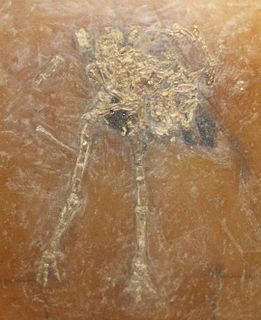 W
WIdiornithidae is an extinct family of Cariamiformes. Fossils of these birds were found mainly in the phosphorus layers of Quercy in south-western France. Other specimens have been found throughout Germany as well.
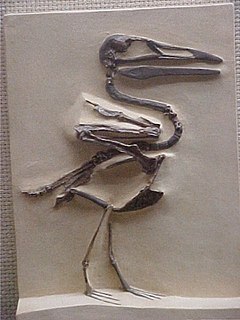 W
WOdontognathae is a disused name for a paraphyletic group of toothed prehistoric birds. The group was originally proposed by Alexander Wetmore, who attempted to link fossil birds with the presence of teeth, specifically of the orders Hesperornithiformes and Ichthyornithiformes. As such they would be regarded as transitional fossils between the reptile-like "Archaeornithes" like Archaeopteryx and modern birds. They were described by Romer as birds with essentially modern anatomy, but retaining teeth.
 W
WOmnivoropterygidae is a family of primitive avialans known exclusively from the Jiufotang Formation of China. They had short skeletal tails and unusual skulls with teeth in the upper, but not lower, jaws. Their unique dentition has led some scientists to suggest an omnivorous diet for them. The family was named by Stephen A. Czerkas & Qiang Ji in 2002, though its junior synonym Sapeornithidae is often used instead, though it was named four years later in 2006. It is the only named family in the order Omnivoropterygiformes.
 W
WPalaeeudyptes is an extinct genus of large penguins, currently containing four accepted species. They were probably larger than almost all living penguins, with the smaller species being about the size of an emperor penguin and the largest ones having stood about 2 meters tall.
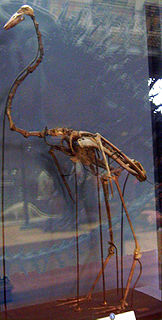 W
WPalaelodidae is a family of extinct birds in the group Phoenicopteriformes, which today is represented only by the flamingos. They have been described as "swimming flamingos."
 W
WThe Pelagornithidae, commonly called pelagornithids, pseudodontorns, bony-toothed birds, false-toothed birds or pseudotooth birds, are a prehistoric family of large seabirds. Their fossil remains have been found all over the world in rocks dating between the Early Paleocene and the Pliocene-Pleistocene boundary.
 W
WPresbyornithidae is an extinct group of birds with a global distribution. They had evolved by the late Cretaceous period and became extinct during the early Miocene. Initially, they were believed to present a mix of characters shown by waterbirds, shorebirds and flamingos and were used to argue for an evolutionary relationship between these groups, but they are now generally accepted to be waterfowl closely related to modern ducks, geese, and screamers.
 W
WPygostylia is a group of avialans which includes the Confuciusornithidae and all of the more advanced species, the Ornithothoraces.
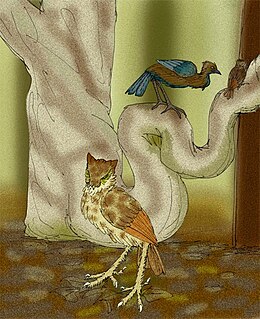 W
WThe Sophiornithidae are an extinct family of chicken-sized predatory birds that lived from the Paleocene to the Eocene periods of the Cenozoic, and were found primarily in Europe, and are thought to be primitive owls.
 W
WTyto robusta was a prehistoric barn-owl. It lived at what is now Monte Gargano in Italy, and was an island throughout much of the Neogene when sea levels were higher. The owl's remains date back to the Miocene-Pliocene boundary 5.5 to 5 million years ago. The fossil bones are about 60% as long again as a modern barn owl, giving a total length of about 50–65 cm for T. robusta. This owl provides an interesting case study of evolution and insular gigantism.
 W
WVegaviidae is an extinct basal family of anserimorph birds which existed from the Late Cretaceous to the Early Paleogene periods with fossils found in Canada, Chile, New Zealand, and Antarctica.
 W
WZygodactylidae is a family of extinct birds found in Europe and North America from the Eocene epoch to the Middle Miocene. First named in 1971, based on fragmentary remains of two species from Germany, a more complete description of the birds became possible in 2008 when a number of other, better-preserved fossil species were assigned to the family based on a number of shared characteristics.